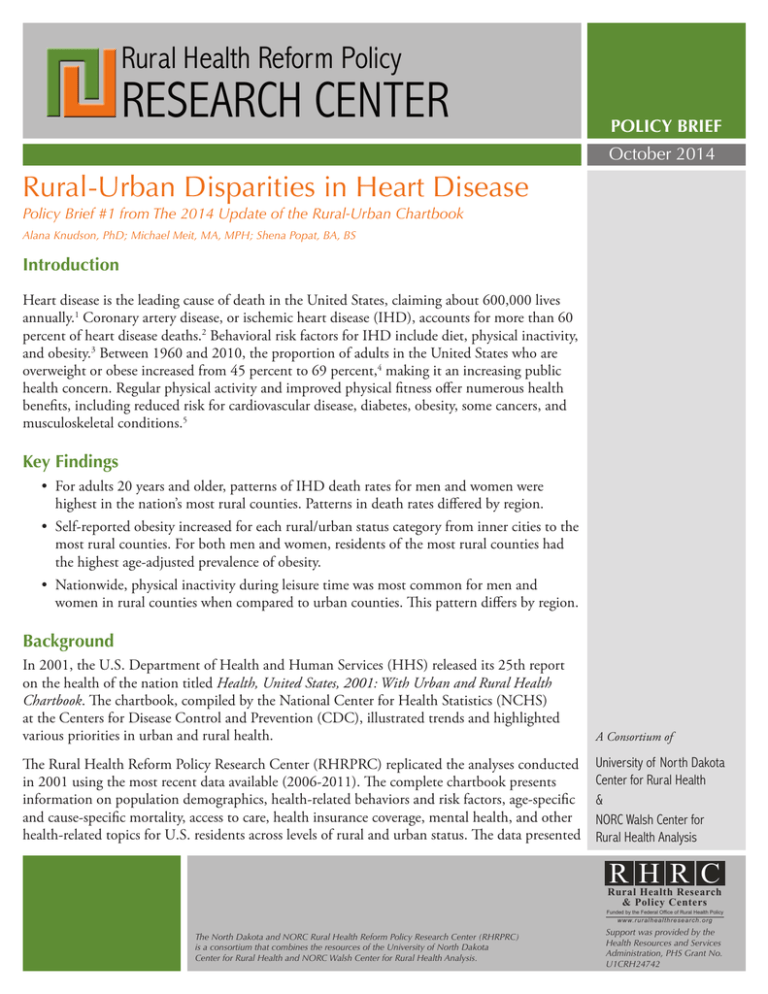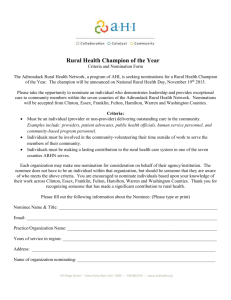RESEARCH CENTER Rural Health Reform Policy Rural-Urban Disparities in Heart Disease
advertisement

Rural Health Reform Policy RESEARCH CENTER POLICY BRIEF October 2014 Rural-Urban Disparities in Heart Disease Policy Brief #1 from The 2014 Update of the Rural-Urban Chartbook Alana Knudson, PhD; Michael Meit, MA, MPH; Shena Popat, BA, BS Introduction Heart disease is the leading cause of death in the United States, claiming about 600,000 lives annually.1 Coronary artery disease, or ischemic heart disease (IHD), accounts for more than 60 percent of heart disease deaths.2 Behavioral risk factors for IHD include diet, physical inactivity, and obesity.3 Between 1960 and 2010, the proportion of adults in the United States who are overweight or obese increased from 45 percent to 69 percent,4 making it an increasing public health concern. Regular physical activity and improved physical fitness offer numerous health benefits, including reduced risk for cardiovascular disease, diabetes, obesity, some cancers, and musculoskeletal conditions.5 Key Findings • For adults 20 years and older, patterns of IHD death rates for men and women were highest in the nation’s most rural counties. Patterns in death rates differed by region. • Self-reported obesity increased for each rural/urban status category from inner cities to the most rural counties. For both men and women, residents of the most rural counties had the highest age-adjusted prevalence of obesity. • Nationwide, physical inactivity during leisure time was most common for men and women in rural counties when compared to urban counties. This pattern differs by region. Background In 2001, the U.S. Department of Health and Human Services (HHS) released its 25th report on the health of the nation titled Health, United States, 2001: With Urban and Rural Health Chartbook. The chartbook, compiled by the National Center for Health Statistics (NCHS) at the Centers for Disease Control and Prevention (CDC), illustrated trends and highlighted various priorities in urban and rural health. A Consortium of The Rural Health Reform Policy Research Center (RHRPRC) replicated the analyses conducted in 2001 using the most recent data available (2006-2011). The complete chartbook presents information on population demographics, health-related behaviors and risk factors, age-specific and cause-specific mortality, access to care, health insurance coverage, mental health, and other health-related topics for U.S. residents across levels of rural and urban status. The data presented University of North Dakota Center for Rural Health & NORC Walsh Center for Rural Health Analysis RHRC Rural Health Research & Policy Centers Funded by the Federal Office of Rural Health Policy www.ru ralhealt hresearch. org The North Dakota and NORC Rural Health Reform Policy Research Center (RHRPRC) is a consortium that combines the resources of the University of North Dakota Center for Rural Health and NORC Walsh Center for Rural Health Analysis. Support was provided by the Health Resources and Services Administration, PHS Grant No. U1CRH24742 Rural-Urban Disparities in Heart Disease POLICY BRIEF in this new Chartbook were collected prior to implementation of the Patient Protection and Affordable Care Act (ACA), providing baseline measurements for key aspects of health from which to measure future ACA-associated changes. Methods This policy brief focuses on three measures: 1) death rates for ischemic heart disease (IHD) among persons 20 years of age and older, 2) obesity among persons 18 years of age and older, and 3) physical inactivity during leisure time among persons 18 years of age and older. The RHRPRC replicated the analyses conducted by CDC in 2001 using the most recent data available for U.S. residents across types of communities from inner cities to small rural areas (defined below) and geographic region of the U.S.—Northeast, Midwest, South, and West, as defined by the U.S. Bureau of the Census. Data sources included the CDC National Center for Health Statistics (NCHS) National Vital Statistics System and National Health Interview Survey. All percentages and rates were age adjusted. Obesity was defined as body mass index ≥ 30 based on selfreported height and weight. Rural/Urban Status Categories Defined Counties were classified into five categories — three for urban (Metropolitan) counties and two for rural (Nonmetropolitan) counties. From most urban to most rural, the categories are: Urban (Metropolitan) counties: A. Inner Cities (Large central) - counties in Metropolitan Statistical Areas (MSA) of 1 million or more population that: 1. Contain the entire population of the largest principal city of the MSA; 2. Are completely contained in the largest principal city of the MSA; or 3. Contain at least 250,000 residents of any principal city of the MSA. B. Suburban (Large fringe) - remaining counties in MSAs with a population of at least 1 million residents. C. Small Metro - counties in MSAs with a population of less than 1 million residents. Rural (nonmetropolitan) counties: D. Large Rural (Micropolitan) – counties in Micropolitan Statistical Areas (population of 10,000 to 49,999) – historically considered rural. E. Small Rural (Non-core) – remaining Nonmetropolitan counties that are not in a Micropolitan Statistical Area. The 2006 NCHS Urban-Rural Classification Scheme for Counties is based on the OMB’s December 2005 delineation of MSAs and Micropolitan Statistical Areas.6 Page 2 October 2014 POLICY BRIEF Rural-Urban Disparities in Heart Disease Findings Heart Disease Nationwide, as shown in Exhibit 1, IHD death rates for both men and women of 20 years or older were highest in small rural counties. For men, the rate was 271 deaths per 100,000, which is about 18 percent higher than in suburban counties, where the rate was lowest. For women the death rate in the most rural counties was 153 per 100,000, which is about 20 percent higher than in small metro counties, where the rate was lowest. Among adults 20 years of age and older, patterns of IHD death rates vary by sex, rural/urban status, and region (Exhibit 2). Death rates for IHD were higher in men than in women across rural/urban status categories for every region. In the Northeast, the death rate was much higher in inner cities and lowest in small metro counties. In the Midwest, death rates were lower in all three urban county categories than in rural counties. In the South, death rates were highest in the small rural counties category and lowest in suburban counties. And in the West, death rates were highest in inner cities and lowest in small rural counties. October 2014 Page 3 Rural-Urban Disparities in Heart Disease POLICY BRIEF Obesity Nationally, self-reported obesity increased for both males and females from a low in inner cities to a high in small rural counties, as shown in Exhibit 3. In 2010-2011, women living in inner cities nationwide reported the lowest age adjusted prevalence of obesity (29 percent) while women in small rural counties the highest (40 percent). The pattern for men was the same as for women; self-reported obesity rates were higher in small rural counties than inner cities.The lowest rates for men were reported in inner cities (26 percent) while the highest rates were observed in small rural counties (35 percent). A similar trend was seen at the regional level (Exhibit 4). Among both men and women, self-reported obesity was higher in rural counties (33-40 percent) than in urban counties (23-32 percent) in all regions. Across regions, the highest self-reported obesity rate among men was in rural counties in the West (36 percent, while, among women, it was in rural counties in the South (40 percent). * The data are presented as rates of physical inactivity, where the definition of physical activity is limited to “exercise, sports, or physically active hobbies” pursued during a person’s leisure time. Page 4 October 2014 POLICY BRIEF Rural-Urban Disparities in Heart Disease Physical Inactivity In Exhibit 5, nationwide physical inactivity during leisure time* was least common for suburban residents (26 percent for men and 32 percent for women) in 2010-2011. Lack of physical activity was most commonly reported for men and women in small rural counties (41 percent for both). Patterns of physical inactivity differed by region, as shown in Exhibit 6. Within each region, however, the trends for men and women tended to be similar, with the exception of the West. In the West, inactivity rates reported by men were highest in all rural counties (28 percent) whereas they were highest in inner cities among women (29 percent). In the Northeast, physical inactivity rates were higher in inner cities (42 percent of men and 48 percent of women) than other rural/urban status categories (25-34 percent of men and 28-40 percent of women). In the Midwest and South, physical inactivity was highest in all rural counties (38 percent and 45 percent, respectively). October 2014 Page 5 Rural-Urban Disparities in Heart Disease Conclusion Nationally, rural residents generally fare worse than their urban counterparts in heart disease deaths, as well as the associated risk factors of obesity and physical inactivity. The Americans who generally fare best on these health indicators are residents of suburban and small metro counties. However, these trends differ by region and sex. IHD death rates are much higher among men than women, but obesity and physical inactivity rates are higher among women than men. While IHD mortality is lower for women, it is still the leading cause of death for all American women.7 Implications Cardiovascular health is affected by both individual behavior and the physical and social environments;8 thus, interventions to address cardiovascular health should address both the individual and their environments. Interventions should be targeted within regions and types of rural/urban area categories with high prevalence rates. Rural communities can implement policy, system, and environmental changes to support healthy behaviors. There are a number of resources to assist rural communities to identify promising practices to improve the health of rural residents, such as the Rural Assistance Center’s Rural Community Health Gateway (www.raconline.org/ communityhealth/). References/Notes 1. National Center for Chronic Disease and Health Promotion. Division for Heart Disease and Stroke Prevention. “Heart Disease Facts.” Centers for Disease Control and Prevention, 2013. http://www.cdc.gov/ heartdisease/facts.htm. 2. Centers for Disease Control and Prevention. National Center for Health Statistics. Deaths: Final data for 2010. By Sherry L. Murphy, Jiaquan Xu, and Kenneth D. Kochanek. National Vital Statistics Reports: Vol. 61 No. Page 6 October 2014 POLICY BRIEF 4. DHHS Publication No. 2013–1120. Hyattsville, MD: National Center for Health Statistics, 2013. Available at http://www.cdc.gov/nchs/data/nvsr/nvsr61/nvsr61_04.pdf 3. National Center for Chronic Disease and Health Promotion. Division for Heart Disease and Stroke Prevention. “Heart Disease Behavior.” Centers for Disease Control and Prevention, 2013. http://www.cdc.gov/ heartdisease/behavior.htm. 4. National Center for Health Statistics. Health, United States, 2011: With Special Feature on Socioeconomic Status and Health (table 74). Hyattsville, MD. 2012. Available at http://www.cdc.gov/nchs/data/hus/hus11.pdf. 5. National Center for Chronic Disease Prevention and Health Promotion. Division of Nutrition, Physical Activity and Obesity. “Physical Activity and Health: The Benefits of Physical Activity.” Centers for Disease Control and Prevention, 2011. Available at http://www.cdc.gov/ physicalactivity/everyone/health/index.html 6. CDC National Center for Health Statistics. “NCHS Urban-Rural Classification Scheme for Counties.” Centers for Disease Control and Prevention, 2014. Available at http://www.cdc.gov/nchs/data_access/urban_rural.htm. 7. National Center for Chronic Disease Prevention and Health Promotion. Division for Heart Disease and Stroke Prevention. “Women and Heart Disease Fact Sheet.” Centers for Disease Control and Prevention. 2013. Available at http://www.cdc.gov/dhdsp/data_statistics/ fact_sheets/fs_women_heart.htm. 8. Healthy People 2020. “Heart Disease and Stroke.” U.S. Department of Health and Human Services. Available at https://www.healthypeople.gov/2020/topicsobjectives/topic/heart-disease-and-stroke. Center Contact Center for Rural Health University of North Dakota School of Medicine & Health Sciences 501 North Columbia Road Stop 9037 Grand Forks, ND 58202-9037 701.777.3848 ruralhealth.und.edu Director Gary Hart, PhD gary.hart@med.und.edu Additional Information Support for this Policy Brief was provided by the Office of Rural Health Policy, Health Resources and Services Administration, PHS Grant No. U1CRH24742 Authors Alana Knudson, PhD, NORC Walsh Center for Rural Health Analysis Michael Meit, MA, MPH, NORC Walsh Center for Rural Health Analysis Shena Popat, BA, BS, NORC Walsh Center for Rural Health Analysis NORC Walsh Center for Rural Health Analysis 4350 East West Highway, Suite 800 Bethesda, Maryland 20814 301.634.9300 walshcenter.norc.org Deputy Director Alana Knudson, PhD knudson-alana@norc.org 301.634.9326



